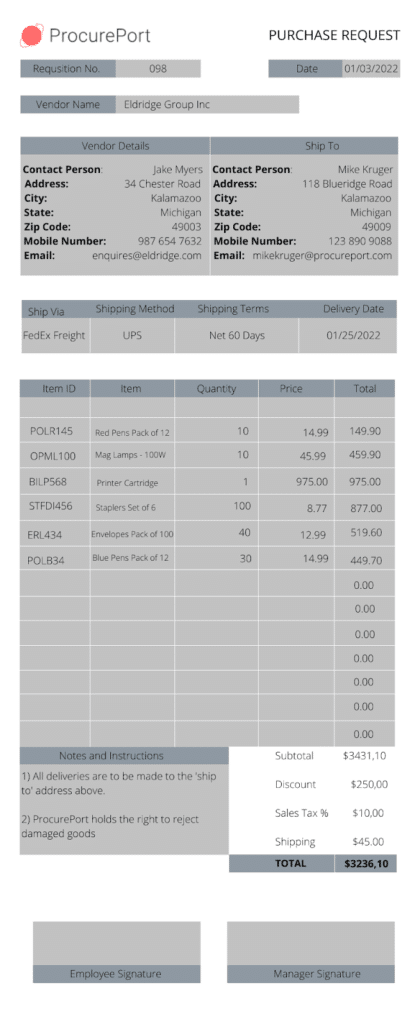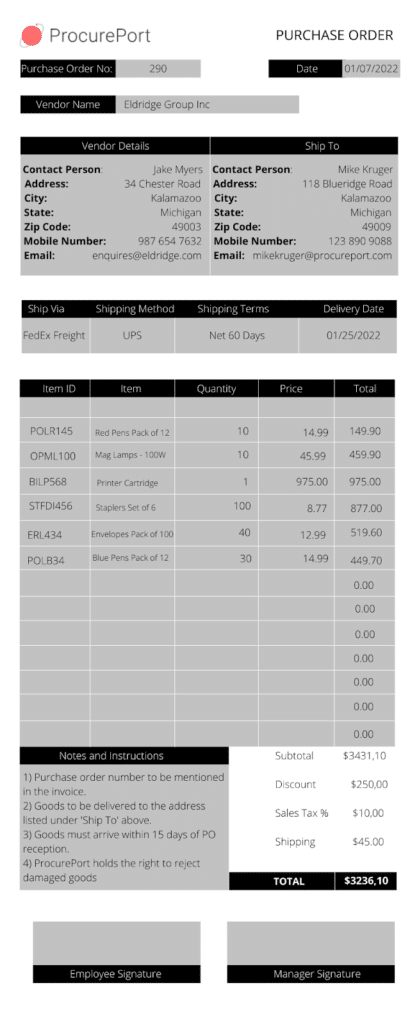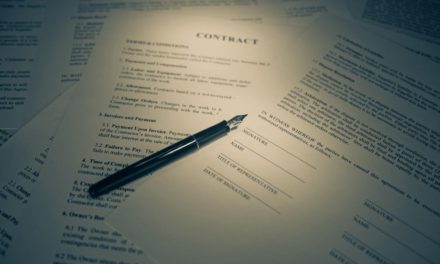The world of procurement is so vast and can be quite complex. Common terms such as ‘requisitions’ and ‘purchase orders’ can be easily mixed up.
If you’ve ever wondered: What do these terms actually mean? Are requisitions and purchase orders the same thing? How do their roles differ in a procurement life cycle? Keep reading.
What is a Purchase Requisition?
According to the Chartered Institute of Procurement and Supply’s (CIPS) glossary of procurement terms, a purchase requisition (PR) is:
“An internal document raised by a user or a store to communicate to procurement the need to buy the product or service specified.”
A purchase requisition is like a ‘to-buy’ list generated by an employee. It starts the purchase process by first identifying the business wants and obtaining permission to have the required goods bought.
This is the document that is used when there is a need to stock up on products running low or a company needs to contract or outsource services.
Here’s a sample of what a purchase requisition order can look like:

Purchase requisitions are designed to provide procurement managers with the information necessary to make a decision about procurement. Information contained on the purchase requisition form includes:
· The name of the vendor
· Their address
· The items needed, their quantities, and prices
· Name, contact details, and department of purchaser
Purchase requisitions are for internal use only and therefore have no legal connotation.
Some companies are likely to only ever use a purchase requisition if the items being procured go above a certain dollar figure.
Purchase requisitions also provide the finance department with insight that helps them plan for spending.
The Importance of Purchase Requisitions
Are purchase requisitions and purchase orders really necessary? Let’s tackle purchase requisitions first and why they are important.
1. Purchase Requisitions Provide a Clear Paper Trail
Visibility is key when trying to cut back on spending. Like the late management specialist Peter Drucker used to say, “You can’t manage what you don’t measure.”
By having a clear record of what was purchased over the months, finance departments can identify areas where money is going and come up with strategic ways to mitigate spending.
For example, they might notice that requests are made for stationery every second month. In this way, stationery can be bought in bulk once per year. This will significantly help push costs down.
2. Purchase Requisitions Provide Order and Structure
Enterprises run on systems. As a core business function, procurement cannot be done haphazardly. It is also a system with its own steps on how it is to be fulfilled.
The starting point for the procurement life cycle is purchase requisitions. Having such a starting point provides clarity, establishes who can place requests, and who can approve them.
Learn more: purchasing and supply chain management in 2020
3. Purchase Requisitions Mitigate Internal Fraud
If anyone in the company can place requests about what should be bought and make vendor suggestions, it greatly magnifies the likelihood of fraud.
By having a formal requisition process, however, fraud can be detected much more quickly and the fraudulent person identified and dealt with expeditiously.
4. Accounts Payable Department Have Direct Purchasing Control
It’s the accounts payable team that has the final say as to whether the enterprise can and will pay the vendor. The system of purchase requisitions makes it possible to decentralize the buying decisions and ensures the finance team has direct control over enterprise buying.
Learn more: What is accounts payable? What is the process and what is included?
How Purchase Requisition Works
There are only three steps involved when it comes to how purchase requisitions work.
1. Identification of needed products and or services by an employee
2. Filling in a purchase requisition form including item description, prices, and recommended vendor
3. Forwarding of purchase requisition to accounts payable department for approval
What is a Purchase Order?
We turn once again to CIPS to give us a comprehensive definition of a purchase order (PO). A PO is a:
“…commercial document issued by a buyer to a seller confirming the goods or services required together with the quantity and specification needed.”
Following the approval of the purchase requisition, the purchasing team then uses the PR as a template to create a purchase order to be sent to the vendor.
The major distinguishing difference between a PR and a PO is the fact that the purchase order is for external purposes and consequently is a legally binding contract once accepted for fulfillment by the vendor. Purchase orders are also NOT invoices.
Here is a sample purchase order:

Purchase orders furnish the vendor with all the information they need in order to fulfill the order as well as provide details of the buyer’s terms and conditions. Hence, what you’ll often see on POs is:
· The name of the buyer (i.e. name of the company making the purchase)
· Name of the person making the order on behalf of the company
· Date of PO creation
· Description of items and respective prices
· Payment terms
· Signature of both buyer and vendor
How Purchase Orders Work
There are also three steps when it comes to explaining how purchase orders work.
1. Purchasing department waits to receive an approved purchase requisition
2. Purchasing department then creates a purchase order using approved PR as a template
3. If PO doesn’t exceed the set dollar amount it is sent to the buyer immediately. If the PO exceeds the set dollar amount, then approval must be granted by the VP before the document is sent to the supplier.
Purchase Requisition vs Purchase Order the Differences Summarized
If you’d like a visual of the differences between purchase requisitions and purchase orders here you go:

Wrap Up
Companies can take advantage of purchase requisitions and purchase orders to help carefully plan their purchasing decisions, so they can reduce spend, and allocate resources strategically throughout the year.
If you’re looking for reliable, robust, and innovative purchasing and supply chain management solutions look no further than ProcurePort. Our software is trusted and used by enterprises and organizations such as UNOPS, HUD.GOV, and conEdison.
To discuss procurement software with a consultant or to schedule a demo of our solutions, contact us today.
Understanding about RFQ Software with the help of our new website!










